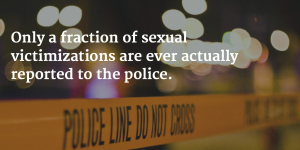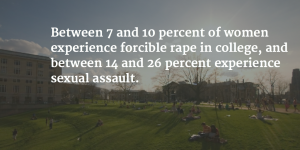Recent scandals about sexual assaults on college campuses have provoked vehement debates about the scope of the problem. According to the White House task force formed to investigate the issue, 20 percent of undergraduate women — 1 in 5 — are sexually assaulted while in college. But some observers claim the problem has been blown way out of proportion. For example, Christina Hoff Sommers argued in a May 2014 article in Time magazine that this number is derived from biased samples and poorly-designed survey questions. Instead, she claims, only one-in-forty college women is a victim of rape or sexual assault.
Disagreement is not confined to political debate. In a 2011 report, the Bureau of Justice Statistics acknowledged that competing estimates of sexual violence have existed for two decades without ever being definitively resolved. In this brief we evaluate existing knowledge about the incidence and prevalence of sexual victimization of women attending American colleges and universities. We follow the Bureau of Justice Statistics definition of rape as a form of sexual assault that includes forced sexual intercourse, whether by physical or psychological coercion, involving penetration by the offender(s). We include in our definition of rape any act of sexual intercourse performed on an individual who is incapacitated as a result of being comatose, drugged, or asleep. To avoid ambiguity, we do not include sexual coercion or unwanted sexual contact such as grabbing or fondling—although the latter also meets the Bureau of Justice Statistics definition of sexual assault. Comparing multiple public health surveys—including nationally representative population surveys—we find it likely that between 7 and 10 percent of women experience forcible rape in college, and that somewhere between 14 and 26 percent experience sexual assault.
The National Crime Victimization Survey (NCVS)

The NCVS, conducted by the Bureau of Justice Statistics, is the nation’s primary source of information about criminal victimization, collecting data annually from about 90,000 households, comprising 160,000 persons. It asks about a range of topics including robbery, simple and aggravated assault, theft, household burglary, and motor vehicle theft, as well as sexual victimization. It is the only such survey that has been fielded annually, using the same methods and questions, over a long period of time (since 1973). It is thus the only source for data on changes over time in the rates of sexual victimization in the U.S., and the most reliable source for comparing the rates of victimization of different groups in the population. Police reports offer another source of information about sexual victimization, but they are problematic because only a fraction of sexual victimizations are reported to the police.
Despite these advantages, questions have been raised about the reliability of NCVS estimates of sexual victimization. In 2011 the Bureau of Justice Statistics (BJS) asked the National Research Council, through its Committee on National Statistics, to convene an expert panel to investigate the possible underestimation of rape in the National Crime Victimization Survey (NCVS). National Academy of Sciences panels undergo rigorous peer review, and the entire committee must sign off on the final report, which gives their findings much weight in the scientific community. In this case, The Panel on Measuring Rape and Sexual Assault in Bureau of Justice Statistics Household Surveys (hereafter, “the Panel”) identified methodological problems with the NCVS that may lead to significant undercounting of rape and sexual assault.
First, the panel found that the fact that the survey is explicitly about crime likely inhibits reporting of assaults. Studies have consistently shown that many women do not label as “rape” or define as criminal many sexual incidents that are unwanted and meet standards of forcible rape. Some respondents may also think that only events reported to the police should be reported on a government crime survey. Others may fear that reporting the assault as a “crime” will get the perpetrator in trouble—something they may not want to do if he is a relative or partner.
Second, the data collection mode of the NCVS does not ensure privacy. The interviewer is required to question everyone 12 and older at designated households, which means that all residents know what others are being asked. These oral interviews may be overhead. Even if not overheard, other members of the household may be suspicious if an interview takes a long time. Given the special stigmatization attached to sexual behavior, this lack of privacy may impede reporting. The Panel additionally found that the NCVS may have recorded a person’s refusal to answer questions about sexual victimization as evidence that violence did not occur.

Third, there are serious problems with the questions about sexual victimization. The NCVS does not ask about incapacitated rape. It asks about “rape,” attempted rape,” and “other type of sexual attack”—but all these terms have ambiguous meanings. Unlike national public health surveys, which ask more behaviorally specific questions about sexual victimization, the NCVS terms failed to “describe behavior or convey the complexity of the intended concepts; a respondent might not realize that what she or he experienced did in fact fit the definition of attempted rape, and the questionnaire does not provide definitions.”
An indication of how these features of the survey lead to under-reporting can be found in a systematic comparison of public health and criminal justice methodologies undertaken by Bonnie Fisher and colleagues as part of the National College Women Sexual Victimization Survey (NCWSV). The researchers worked with the Bureau of Justice Statistics to simultaneously conduct two studies using an experimental design. One set of respondents was asked questions about sexual victimization using a screening questionnaire asking 10 behavioral specific questions (e.g. “has anyone made you have sexual intercourse by using force or threatening to harm you or someone close to you?”). The other set of respondents was questioned using the NCVS protocol, which skipped people past any further questions about sexual victimization if they responded negatively to a question “have you been forced or coerced to engage in unwanted sexual activity?” The two studies were both in the field in 1996 and—aside from the question wording—employed exactly the same design. In both cases, participants were asked to report incidents that occurred within the approximately seven months “since school began in fall 1996.”
The crime wording captured just 9.4 percent of the incidents of completed rape reported by respondents who were asked the behaviorally worded questions. No wonder the Panel found that even the most conservative of the public health surveys, the 1990 National Women’s Study (NWS), produced an estimate of completed rape five times higher than that produced by the NCVS. The Panel judged the problems with the NCVS to be so fundamental that sexual victimization could not be accurately measured within the context of an omnibus crime survey. The Panel recommended that the Bureau of Justice Statistics develop a separate survey for measuring rape and sexual assault.
Declines in Rape and Sexual Assault Over Time
Although the National Crime Victimization Survey probably underreports rape and sexual assault, its methodology has been largely consistent over time. As a result, the NCVS may capture trends in violence even if it does not accurately estimate the absolute level at any particular time. NCVS data suggest that sexual victimization has declined over time. A Bureau of Justice Statistics report published in March 2013 and based on NVCS data, “Female Victims of Sexual Violence, 1994–2010” found that “From 1995 to 2005, the total rate of sexual violence committed against U.S. female residents age 12 or older declined 64%. … It then remained unchanged from 2005 to 2010.” On the other hand, public health surveys do not show a decline in estimates of rapes over time—even when restricting analysis to questions about forcible rape.
Higher Victimization Rates of Young Women Not in College
It is often assumed that female college students are at increased risk compared to their peers of the same age who are not attending college. Yet a Bureau of Justice Statistics Report entitled “Rape And Sexual Assault Among College-Age Females, 1995-2013” published in December 2014 found that 18-to-24 year old females not enrolled in a post-secondary school were 1.2 times more likely to experience rape and sexual assault victimization than college students in the same age range. These estimates were drawn from the NCVS, which does not ask about rape while incapacitated as a result of drugs or alcohol. Since a substantial amount of rape and sexual assault on campus involves using alcohol as a means of rendering victims unable to resist, the above study may underestimate the risk to students. Still, as Jennifer Barber documents in her related policy brief, women who are not in college experience more intimate partner violence in dating and romantic relationships than college women. It is possible that alcohol-facilitated sexual assault may be more common among college women, while intimate partner violence may be more common among non-college women.
Surveys of College Women: Prevalence of Sexual Assault
The NCVS is not the only source of data on the incidence and prevalence of rape and sexual assault. We focus here on the results of five different surveys of college women’s sexual victimization conducted between 1984 and 2014 (see the Appendix for details about these and other surveys and Table 1 for results). We compared responses to the question about forced sexual intercourse across the five surveys, throwing out the highest estimate (which included rapes since age 14, and which was conducted in 1984) and the lowest estimate (which included only women attending MIT and did not isolate seniors). The College Sexual Assault (CSA) and Online College Social Life (OCSLS) surveys asked college seniors about the entirety of their time in college, producing estimates of 7 percent and 10 percent, respectively. The third study, the National College Women Sexual Victimization (NCWSV), asked only about incidents that occurred in the last 7 months. Multiplying the 1.7 percent incidence found in that survey by 5 (to cover 35 months on campus) offers a rough estimate of the risk over the course of college. This produced an estimated prevalence rate of 8.5. Taken together, these studies suggest that between 7 and 10 percent of undergraduate women experience forcible rape in college.
To calculate the prevalence of sexual assault in college, we combined responses to the question about forced sex with questions about incapacitated and attempted rape. The Online College Social Life (OCSLS) survey asked respondents these questions: “Since you started college, has someone tried to physically force you to have sexual intercourse, but you got out of the situation without having intercourse?” and “Since you started college, has someone had sexual intercourse with you that you did not want when you were drunk, passed out, asleep, drugged, or otherwise incapacitated?” Focusing on the three surveys above, we found affirmative responses ranging from 14 to 26 percent. That the estimates range from about 1 in 7 to 1 in 4 is not satisfying—but even the lowest one is far higher than the 1 in 40 number that Hoff Sommers cited, and they do not include cases of unwanted touching, grabbing, or fondling or psychological coercion (e.g. situations where individuals consent to sex after begging or pleading).
These surveys suggest that the 1 in 5 statistic so frequently quoted is reasonable, even though inexact. The two most comparable recent surveys—the CSA and OCSLS — converge on a figure of 25 to 26 percent of college women experiencing sexual assault in college—as Jessie Ford and Paula England note in a recent discussion of the finding of the Online College Social Life Survey.
The results of these surveys are certainly not definitive. The Campus Sexual Assault (CSA) survey studied only two universities and all the surveys had small sample sizes. Only two of the studies employed a national sampling frame. The problem is less with the flaws of particular studies, and more with the lack of a sustained national investment in collecting high quality data on the issue. The federal government only initiated a large-scale, annual, nationally representative public health survey of sexual victimization in 2010—the National Intimate Partner and Sexual Violence Survey (NISVS). This survey found that 12.3 percent of women of all ages reported having experienced forced intercourse. Because young women are more at risk of sexual victimization, this is compatible with the estimate that 7 to 10 percent of women experience forcible rape in college.
We were also able to compare the above surveys with highly regarded demographic surveys (see the Appendix for details on these surveys). These surveys asked only a few questions about sexual victimization and did not focus on college women, but nonetheless served as a useful check on the results of the surveys discussed above. For example, we looked at the National Survey of Family Growth (NSFG), which is conducted by the Centers for Disease Control. Based on a large (n=@19,000) nationally representative sample, it is the most widely used source of information about patterns of pregnancy, contraception, and fertility in the U.S. This survey found that just under 20 percent of 20–24 year old women surveyed in 2002 reported having ever experienced forced intercourse.
Conclusion

There are several reasons we do not have better data. Attitudes about what forms of nonconsensual sex are unacceptable have been in flux throughout the period under discussion in this report. In historical terms, changes in laws and attitudes about nonconsensual sex have been rapid: rape within marriage was not criminalized in all 50 U.S. states until 1993. Even now, some people view nonconsensual grabbing and fondling of young women as normal and acceptable, particularly when young women are socializing with same-age peers. What constitutes consent and what forms of unwanted sexual activity constitute assault continue to be contested.
In addition, gender-based violence has not been a central concern of U.S. family demographers or the National Institutes of Health, despite the fact that gender-based violence may be related to outcomes such as early and unintended pregnancy, inconsistent contraceptive use, engagement in risky health behaviors, and educational attainment.
Despite the limits of the existing data, we can all agree that even the lowest estimates represent substantial numbers of women who experience sexual assault or rape, and surely we can also agree that better data is needed to develop appropriate responses to sexual violence on campus and beyond, as well as to determine what preventative measures are most likely to work. We should encourage the Bureau of Justice Statistics to implement the recommendations of the Panel on Measuring Rape and Sexual Assault in Bureau of Justice Statistics Household Surveys. For now, though, we believe it is reasonable — even conservative — to work on the assumption that without stronger preventive action, somewhere between 14 and 26 percent of female undergraduates will experience sexual assault during their time in college.
—
This was part of the CCF Online Symposium on Intimate Partner Violence
References
Abbey, A. (2002). Alcohol-related Sexual Assault: A Common Problem among College Students. Journal of Studies on Alcohol and Drugs, (14), 118. Retrieved from http://collegedrinkingprevention.gov/media/Journal/118-Abbey.pdf
Barber, J.S., Kusunoki, Y., & Budnick, J. (2015). “Women who are not enrolled in four-year universities and colleges have higher risk of sexual assault.” https://contemporaryfamilies.org/not-enrolled-brief-report/
Black, M. C., Basile, K. C., Breiding, M. J., Smith, S. G., Walters, M. L., Merrick, M. T., & Stevens, M. R. (2011). National Intimate Partner and Sexual Violence Survey. Atlanta, GA: CDC. Centers for Disease Control and Prevention. Retrieved from http://www.cdc.gov/ViolencePrevention/pdf/NISVS_Report2010-a.pdf
Bureau of Justice Statistics. (1973-2013). Data Collection: National Crime Victimization Survey (NCVS). Retrieved from http://www.bjs.gov/index.cfm?ty=dcdetail&iid=245
Bureau of Justice Statistics. (2011). BJS Activities on Measuring Rape and Sexual Assault. Retrieved from http://www.bjs.gov/content/pub/pdf/bjs_amrsa_poster.pdf
Bureau of Justice Statistics. (2013) Female Victims of Sexual Violence, 1994-2010. Retrieved from http://www.bjs.gov/content/pub/pdf/fvsv9410.pdf
Bureau of Justice Statistics. (2014). Rape And Sexual Assault Among College-Age Females, 1995-2013. (NCJ 248471). Retrieved from http://www.bjs.gov/content/pub/pdf/rsavcaf9513.pdf
Chandra, A., Martinez, G. M., Mosher, W. D., Abma, J. C., & Jones, J. (2005). “Fertility, Family Planning, and Reproductive Health of US Women: Data from the 2002 National Survey of Family Growth. Vital and Health Statistics. Series 23, Data from the National Survey of Family Growth, (25), 1-160. Retrieved from http://www.cdc.gov/nchs/data/series/sr_23/sr23_025.pdf
Fisher, B. S. (2009). “The Effects of Survey Question Wording on Rape Estimates: Evidence from a Quasi-experimental Design.” Violence Against Women, 15, 133- 147. Retrieved from http://vaw.sagepub.com/content/15/2/133.short. See also https://www.ncjrs.gov/pdffiles1/nij/199705.pdf
Fisher, B., Cullen, F. & Turner, M. (2000). The Sexual Victimization of College Women. (NCJ #182369.) Washington, DC: U.S. Department of Justice, National Institute of Justice. Retrieved from https://www.ncjrs.gov/pdffiles1/nij/182369.pdf
Fisher, B., Daigle, L., Cullen, F., & Turner, M. (2003). “Acknowledging Sexual Victimization as Rape: Results from a National-Level Study.” Justice Quarterly 20(3), 535-574. Retrieved from http://www.tandfonline.com/doi/abs/10.1080/07418820300095611#.VRh1Vjt4odU
Forbes, J. and England, P. (2015). “What Percent of College Women are Sexually Assaulted in College?” Contexts online blog, published by the American Sociological Association. Retrieved from http://contexts.org/blog/what-percent-of-college-women-are-sexually-assaulted-in-college/
Kilpatrick, D.G., Edmunds, C., & Seymour, A. (1992). Rape in America: A Report to the Nation. Charleston, SC: National Victim Center & the Crime Victims Research and Treatment Center, Medical University of South Carolina. Retrieved from https://www.victimsofcrime.org/docs/Reports%20and%20Studies/rape-in-america.pdf?sfvrsn=0
Koss, M. P., Gidycz, C. A., & Wisniewski, N. (1987). “The Scope of Rape: Incidence and Prevalence of Sexual Aggression and Victimization in a National Sample of Higher Education Students.” Journal of Consulting and Clinical Psychology, 55, 162-170. Retrieved from http://www.ncbi.nlm.nih.gov/pubmed/3494755
Krebs, C.P., Lindquist, C.H., Warner, T.D., Fisher, B.S., & Martin, S.L. (2007). The Campus Sexual Assault (CSA) Study. Washington, DC: National Institute of Justice, U.S. Department of Justice. Retrieved from https://www.ncjrs.gov/pdffiles1/nij/grants/221153.pdf
Kruttschnitt, C., Kalsbeek, W. D., & House, C. C. (Eds.). (2014). Estimating the Incidence of Rape and Sexual Assault. National Academies Press. Retrieved from http://www.nap.edu/catalog/18605/estimating-the-incidence-of-rape-and-sexual-assault. For a report brief http://sites.nationalacademies.org/cs/groups/dbassesite/documents/webpage/dbasse_085943.pdf
Massachusetts Institute of Technology. (2014). Survey Results: 2014 Community Attitudes on Sexual Assault. Retrieved from http://web.mit.edu/surveys/health/
Miller, Jody. (2008). Getting Played: African American Girls, Urban Inequality, and Gendered Violence. New York: New York University Press.
White House. (2014). Not Alone: The First Report of the White House Task Force to Protect Students from Sexual Assault. Washington, DC. Retrieved from http:// www.whitehouse.gov/sites/default/files/docs/report_0.pdf
Originally posted 5/07/15

Comments